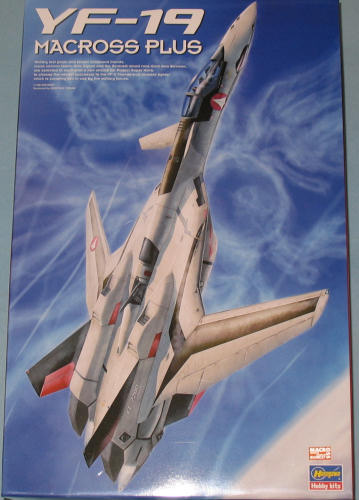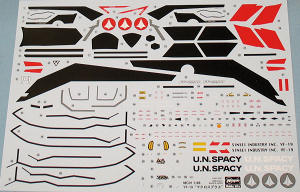
Hasegawa 1/48 YF-19 'Excaliber" MC-1
| KIT #: | ? |
| PRICE: | $55.00 or so from Hobby Link Japan |
| DECALS: | One option |
| REVIEWER: | Dan Lee |
| NOTES: |
Includes crew figure. |

| HISTORY |
The YF-19 comes from a Japanese sequel to the
original Macross Series known as Macross Plus.
The VF-19 Excalibur is the production-line
version of Shinsei Industries' YF-19 AVF Prototype which won the Project Super
Nova design contest of 2040. Although destined to eventually replace the aging
VF-11 Thunderbolt as the main variable fighter for the UN Spacy, distribution to
date has been slow. Currently the Excalibur is being used as a fighter for UN
Spacy colonization fleets. The rare VFs are usually only piloted by the best and
brightest pilots, similar to the status enjoyed by the VF-17 Nightmare. The
VF-19 will gradually phase out and replace the VF-11 as the main fighter of the
UN Spacy.
Statistics
•
Length: 18.62 meters
•
Wingspan: 14.87 meters
•
Height: 3.94 meters (fighter configuration) 15.48 m (battroid
configuration)
•
Weight (Empty): 8,750 kilograms (19,250 lb. or 9.625 tons) (Overload in
Space):
46,102 kilograms (101,424 lb. or 50.71 tons)
•
Maximum Speed: Mach 5.1 @ 22,000 meters
•
Cruising Speed: Mach 1.8 @ 15,000 meters
•
Rate of Climb to 5,000 meters: 65,000 meters per minute
•
Powerplant: Shinsei/P&W/Royce FF2200B x 2, Shinnakasu/P&W/Royce
FF2500E x 2
Three decades after the great war between the humans and the Zentradi the U.N. government is developing new technologies to use in their transforming fighter aircraft by running tests on the colony planet Eden. Military test pilots and former childhood friends, loose cannon Isamu Alva Dyson and the Zentradi mixed race Guld Goa Bowman, are selected to each pilot a new aircraft (Shinsei Industries' YF-19 & General Galaxy's YF-21 for Project Super Nova, to choose the newest successor to the VF-11 Thunderbolt variable fighter which is currently still in use by the UN Spacy military forces. Their own personal grudges end up disrupting the tests, and begin to wreak havoc on the program.
| THE KIT |
 I
picked up this kit because I liked the “Macross” look of the YF-19 not because
I’m a fan of the Macross sequel (I haven’t even seen it.)
I did read somewhere that Hasegawa wants to expand beyond the aircraft
that it is known for.
I
picked up this kit because I liked the “Macross” look of the YF-19 not because
I’m a fan of the Macross sequel (I haven’t even seen it.)
I did read somewhere that Hasegawa wants to expand beyond the aircraft
that it is known for.
It is a typical Hasegawa kit with fine panel
lines and nice details. Instead of
the usual light grey plastic, the majority of the 181 parts comes in a yellowish
tan on 6 sprues with a separate sprue of clear plastic for the canopy and other bits. The instructions are well
done and contain a list of Gunze Creos paint that can be easily converted to
other paints. The majority of the
YF-19 is to be done in a lightened radome tan.
bits. The instructions are well
done and contain a list of Gunze Creos paint that can be easily converted to
other paints. The majority of the
YF-19 is to be done in a lightened radome tan.
The decal sheet is later Hasegawa decals with
white instead of ivory. The
instructions give one the choice of decals or painting certain markings.
I can not vouch for the accuracy as I’m not
very knowledgeable about the subject, but it certainly fits the bill of
something SF and out of the ordinary.
This kit is part of the Hasegawa plan to expand
beyond aircraft into other areas.
| CONCLUSIONS |
I guess being a kid of the 1980s and who grew
up with Robotech and other Japanese mecha anime it is no surprise that I have a
weakness for these new Hasegawa kits.
The YF-19 should be an interesting build.
| REFERENCES |
October 2010 If you would like your product reviewed fairly and quickly, please
contact
me or see other details in the
Note to
Contributors.